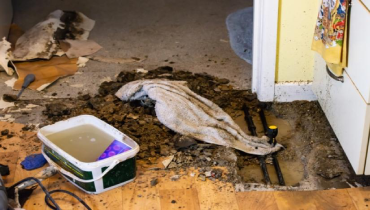
After a flood, homeowners face serious risks that require immediate attention. Rainbow Restoration highlights these key hazards to watch for:
|
Whether caused by broken pipes, leaking appliances, or storms, flooding can do serious damage to your home. As bad as the obvious effects of flooding can be—watermarks on furniture, wet carpets, staining on walls—you may think most of the problems can be solved by just letting everything dry out. Unfortunately, flooding can cause many other issues that aren’t obvious at first glance. These problems may not only cause significant damage to your home if not handled quickly, but they can actually be dangerous to you and your family. The best way to stay safe is to be aware of the type of hazardous situations that are best handled by professionals.
Mold
In 1984, people at Incline Village in Lake Tahoe began to get sick with an illness they called “Yuppie Flu.” However, they soon learned the problem wasn’t being caused by an influenza virus but by toxic mold growth. This was one of the first times people in the United States became aware of how dangerous mold can be. One of the worst things about mold is how quickly it grows— in as little as 24 to 48 hours mold can start growing in areas of your home that you can’t even see. If not dealt with quickly, mold growth can take over your house and, in extreme cases, cause it to become unlivable.
Black Water
All floodwater from outside the home—like lakes and rivers—and water from storm flooding or sewage backups is considered black water. Even overflows from some kitchen sources can be considered black water if it’s been exposed to grease or food waste. Black water may be loaded with contamination, microbes, and biohazards. It’s considered very dangerous because it can cause illness, spread pathogens, and even lead to long-term disease. Because it’s so hazardous, you should never wade through flood water or handle items that are soaked with it. Unfortunately, you can’t tell if water is contaminated just by looking at it. So, unless you know for certain that your floodwater comes from a clean source, it should always be treated like black water and dealt with by a trained professional.
Related Topic: Storm Disasters: The Hidden Damage
Damaged Wiring
After the floodwaters are gone, there can still be other invisible dangers. For example, the wiring in your walls can be damaged if exposed to moisture. Even if it seems like everything is dry, it can still be damp inside the walls. Since water is an excellent conductor of electricity, even a small amount of water touching damaged wiring can be dangerous. In addition, moisture can degrade wiring insulation, which increases the risk of an electrical fire in the future. That’s why it’s important to keep the power disconnected after a flood, until an electrician or some other professional can analyze the damaged wiring and replace it.
Damaged Appliances
There are some appliances that can actually increase the risk of flooding in your home. When this happens, the appliance will need to be repaired or replaced as quickly as possible. However, in the case of a storm or other flooding, it only takes a few inches of water to damage your appliances and your HVAC system. If your appliances are plugged in during a flood, the electrical cords or outlets might end up underwater, creating a very dangerous situation that you shouldn’t try to handle on your own. Even if you think your appliances are all dried out, don’t be tempted to turn them on until an expert makes sure they’re safe.
Damaged Gas Lines
Most of us don’t think of our gas lines being threatened during bad weather. However, downed trees or large amounts of rain can cause the ground to shift, resulting in misaligned or cracked gas pipes. Signs of damaged gas lines include a strong “rotten egg” smell and standing water that bubbles in unusual spots. If you do smell gas, don’t turn on lights, strike a match, use a cell phone, stove/oven, or do anything that might cause a spark. Leave the area immediately and call your local gas company—never try to turn off the gas main yourself!
Pests
Even after the floodwaters are long gone, you could experience a second wave of problems from insects and rodents. When areas flood, animals living underground are forced to abandon their homes. When they lose their dens, rats and mice will start looking for new sources of shelter and food, which might bring them into your home. Even insects that enjoy moisture, like millipedes and termites, will evacuate the ground if it becomes oversaturated. In fact, fire ants can survive floods by clinging together to form a raft, allowing them to float into your yard and set up residence on dryer ground. Because insects and rodents spread disease and can do even more damage to your house, it’s best to call an exterminator as soon as you spot them.
Debris
Flooding, especially due to severe weather, can create dangerous debris flows. Downed trees, building materials, bottles and cans, and even outdoor furniture can create debris that clogs drains and does additional damage to property. Trying to remove debris on your own can cause injuries and expose you to toxic materials. Experts recommend that you don’t try to remove debris yourself but, if you must come in contact with it, be sure to wear the right clothing. Shirts with long sleeves, boots, heavy gloves, goggles, and a mask can offer some protection, but the best way to protect yourself is to call a professional.
Recovery is Possible
The good news is that you can recover from flooding in your home. Prevent further damage and protect yourself from injury by calling the restoration professionals at Rainbow Restoration. When you let them handle all the hazardous situations, it’s easier for you to get back to normal as soon as possible.
